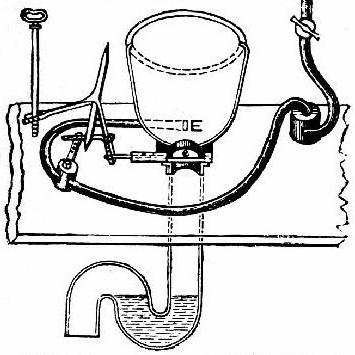
Alexander Cumming invented the S-bend in 1775. Toilets have existed for thousands of years, but the S-band (now the U-bend) was an invention that helped transition to indoor toilets and helped to improve sanitation levels around the world.
Early people used streams running near their settlements for a toilet. That is fine, so long as the settlement remains fairly small. Once you have more people living in the same area, that can lead to problems, as was found in London during the Great Stink. The Sumerians came up with the first toilets. They were deep pits that were fed with ceramic tubes. There was no way to flush the toilets and the pits had to be emptied by hand every now and again. The Babylonians improved on the idea by using water to wash everything into canals. The Romans built public toilets for regular people and private toilets for the wealthy. The toilets were flushed by constantly running water.
As time progressed, toilets didn’t really. Up through the Middle Ages, people still used holes over pits, running water, or just threw their waste out of the window. Many European castles have garderobes, which is a room that protrudes slightly from the wall, with a hole. The toilet was over the hole, and everything could just drop into the moat. Then, there was a leap in toilet technology and Sir John Harrington invented the flushing toilet. In 1596 he built a toilet that was fed by water from a cistern on the second floor of his house and the cistern had to be filled with almost 30 liters of water for each flush. When he was ready, he pulled a lever and all 30 liters of water rushed down a narrow pipe, gaining enough energy from the narrow pipe and the force of gravity to flush everything out of the toilet and down a pipe. Then the cistern had to be refilled by hand.
There were several problems with all of these systems, but the biggest two problems were smell and diseases. The toilet pits and the pipes that led to them would become foul and smell very bad. The toilets in castles were called garderobes because a heavy robe had to be hung over the entrance to keep the smells out of the castle. There was nothing to stop the stench coming back up the pipe and out through the toilet. This was especially noticed during the Great Stink when the Thames was so full of sewage that Parliament had to be abandoned. There were complex sewers beneath many cities, but there was nothing to stop the smell coming back up.
The second problem was disease. Sewage contains an enormous number of bacteria and viruses. They thrive in the environment and toilet pits and pipes can be heavily contaminated. Touching or being exposed to this can be deadly. Rivers and moats used as toilets can also become contaminated. The viruses and bacteria can be carried on the air off the sewage as well. Having a toilet that was just a pipe to a pit meant that the bacteria and viruses could very easily travel back up. The rivers were also near to drinking water sources and disease could travel that way. It is no coincidence that there were many outbreaks of cholera, along with many other diseases.
Alexander Cumming was born in the UK and he was a watchmaker and inventor. He invented a few things that made a difference, such as a barometer that records pressure over time and a machine to make extremely thing slices for scientific research. However, his most important invention, and the one that he couldn’t have foreseen making so much of a difference, was the S-bend. He was toying with the problem of the flushing toilet. There hadn’t been any advances since John Harrington’s flushing toilet and that had never caught on. Improvements in manufacturing meant more complex and accurate parts could be made in Cummin’s era. He designed a toilet that was connected to a water supply and that would flush and then refill itself. That is wonderful, but his addition of an S-bend pipe was the miracle solution.
So, what is the S-bend and how did it help? The problem with all toilets was that the gases from the sewers or the toilet pits came straight back up out of the toilet. The S-bend was an upside down and horizontal “S” shape. The top of the front of the S was connected to the bottom of the toilet and the bottom of the back of the S was connected to the pipe that led to the sewer. The genius of the S-bend pipe was that water would stay in the pipe. The curve of the S was low enough that the water would fill the pipe in the center and cut off the air. No gases from the sewers could get back up the pipe, so long as it had water in it.
Unfortunately, Cumming’s might have been a little ahead of his time because not many people had running water. Still, his invention would revolutionize toilets, with the help of a few other inventors. It also helped to cut down on diseases. And this is what I learned today.
Image By Alexander Cumming – http://www.theplumber.com/closet.html, Public Domain, https://commons.wikimedia.org/w/index.php?curid=76102354
Sources
https://www.baus.org.uk/museum/164/a_brief_history_of_the_flush_toilet
https://www.dw.com/en/a-brief-history-of-the-toilet/a-51310832
https://www.history.com/news/who-invented-the-flush-toilet
https://en.wikipedia.org/wiki/Trap_(plumbing)
https://en.wikipedia.org/wiki/Alexander_Cumming
https://www.betterhealth.vic.gov.au/health/healthyliving/sewage-overflows-at-home
